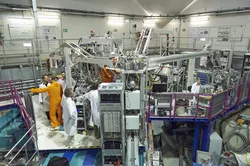Positron source
The Forschungs-Neutronenquelle Heinz Maier-Leibnitz FRM II houses the world's most powerful positron source. It produces a billion positrons per second, which is up to 1000 times more than comparable facilities.
How are positrons generated?
The positrons are indirectly generated by the neutrons in the FRM II. At the tip of the beam tube number 11 is a cap made of cadmium. When thermal neutrons from the moderator tank hit the cadmium, high energy gamma radiation is emitted. Through a platinum foil close to the cadmium tip the energy of this electromagnetic radiation is converted into mass according to the Einstein equivalence of mass and energy E=mc2. Matter and antimatter are generated in equal amounts, which are electrons and positrons in this case. The positrons are extracted from the platinum using electric fields. They are subsequently guided by magnetic fields towards the different experiments.
Four different instruments
Four different instruments use positrons at the FRM II: The Surface Spectrometer SuSpect, the Coincidence Doppler-Broadening Spectrometer (CDBS), the Pulsed Low-Energy Positron System (PLEBS) and the Positron Time of Flight Experiment, which is directly connected to the beam line.
Applications
Apart from basic research, positrons at the instrument NEPOMUC are used in particular for materials research, as they are not only able to detect defects in the atomic structure, but also differentiate between different kinds of atoms. Depending on the element, the positron electron annihilation leads to a different gamma spectrum. The gamma radiation emitted is measured and acts like a fingerprint for the specific element. Using this technique at the FRM II, one layer of zinc atoms was identified from buried below 500 layers of aluminum.
Even missing atoms in the lattice can be detected using positrons. These voids can eventually lead to cracks when the material is mechanically stressed. Positrons are able to detect one missing atom in ten million.
More information on NEPOMUC can be found on the webpage of the Heinz Maier-Leibnitz Zentrum.
